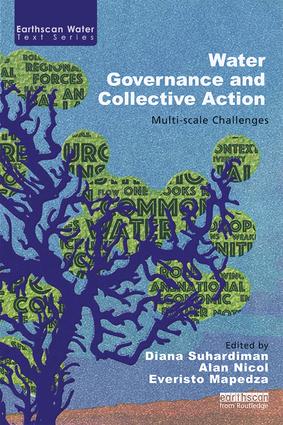
In Water Governance and Collective Action, editors Suhardiman, Nicol and Mapedza argue that globalization and the “dominant neoliberal development agenda” have led to a commodification of natural resources that allows local communities very little agency over the governance of their own resources. How can these weakened communities shape national and transnational water policy in ways that will achieve more sustainable and just outcomes? Sometimes, they suggest, this can be accomplished through collective action.
The authors argue that conventional approaches to identifying factors that lead to collective action (e.g., Ostrom’s Institutional Analysis Development framework) are a good start, but that power also needs to be taken into consideration. Their central argument relies on the Foucauldian understanding of power (i.e., that power is diffuse and constantly in flux), rather than the international relations understanding of hegemony (i.e., that one state “holds” power). While power differences (e.g., between a company siting a dam and the community that will be displaced if the dam is built) will invariably present obstacles to achieving equitable outcomes, the book suggests that local-level communities can sometimes “balance” the playing field through strategic alliances, or by connecting to actors at different scales (e.g., transnational NGOs with overlapping mandates, empathetic politicians, etc.)––in the language of negotiation, through “coalition building.”
The editors pose three questions that reflect the inherent difficulty of governing a resource that crosses multiple scales: “How is collective action shaped by existing power structures and relationships at different scales? What are the kinds of tools and approaches that various actors can take and adopt to achieve more deliberative processes for collective action? What are the anticipated outcomes for the development processes, the environment and the global resource base of achieving collective action across multiple scales?”
They attempt to address these questions by drawing on 13 case studies of collective action from around the world but, as is the case with most books written by multiple authors, there is very little consistency in how well each chapter or case study explicitly addresses these questions. The Introduction briefly summarizes how each case ties to the central argument, and the Conclusion briefly responds to the core questions. The cases themselves, though, move in different directions. Of the discussions concerning the three questions, the second (i.e., that of tools and approaches to more deliberative processes) is the least developed. This positions the book as an extension of an academic debate rather than as a guide for local communities. That said, the overall argument that “less powerful actors” such as “NGOs, local government agencies and civil society groups” (p. 179) have an opportunity to shape how natural resources are used and governed through collective action achieved by developing strategic alliances with actors at different scales is compelling. The same is true of the editors’ call to pay attention to “how development decisions are made, based on what rationale and representing whose interests” (p. 178) to identify ways of influencing policy and institutional change.
Water Governance and Collective Action repeatedly emphasizes the importance of achieving more sustainable and just outcomes in water governance, and carefully balances optimism about the potential for change through collective action with a recognition that the political arena may not always be conducive to change in the status quo. Its call to focus on institutions in analyzing water governance is a promising extension of the state-dominated focus of the “hydro-hegemony” debate because it explicitly recognizes the potential power of local actors and collective action. Arguably, the editors may have chosen only cases that support their argument, but the diversity of cases will nonetheless be of interest to scholars of water governance.
